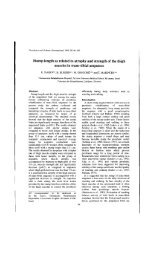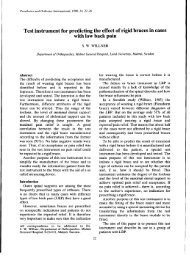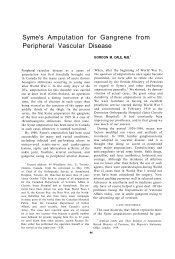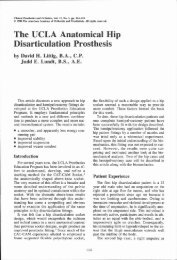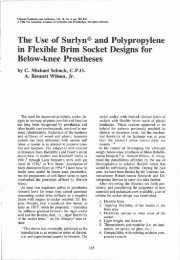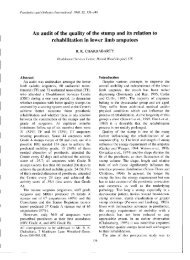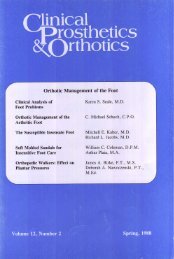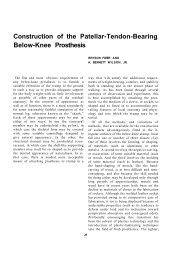The Biomechanics of Control in Upper-Extremity Prostheses
The Biomechanics of Control in Upper-Extremity Prostheses
The Biomechanics of Control in Upper-Extremity Prostheses
You also want an ePaper? Increase the reach of your titles
YUMPU automatically turns print PDFs into web optimized ePapers that Google loves.
BIOMECHANICS OF CONTROL 21<br />
usual for some <strong>in</strong>dividuals to be able to build<br />
up the force available to a value <strong>in</strong> excess <strong>of</strong><br />
100 lb., but such a high force normally is not<br />
required.<br />
THE NATURE AND OPERATION OF CONTROL<br />
SYSTEMS<br />
<strong>The</strong> Below-Elbow S<strong>in</strong>gle-<strong>Control</strong> System<br />
<strong>The</strong> s<strong>in</strong>gle control for the below-elbow amputee<br />
is powered by arm flexion to provide<br />
term<strong>in</strong>al-device operation. This control motion,<br />
used by the above-elbow amputee also,<br />
depends upon a coord<strong>in</strong>ated flexion <strong>of</strong> the<br />
humerus and abduction <strong>of</strong> the scapula on the<br />
amputated side; little shoulder activity is required<br />
on the sound side. It is substantially the<br />
same motion as that used <strong>in</strong> normal unilateral<br />
reach<strong>in</strong>g. <strong>The</strong> displacements <strong>of</strong> humerus and<br />
scapula are additive, so that the result<strong>in</strong>g<br />
motion is quite natural. With full Bowdencable<br />
transmissions <strong>of</strong> power from arm cuff to<br />
forearm socket, there is no <strong>in</strong>fluence <strong>of</strong> elbow<br />
angle, and the operation is mastered easily by<br />
all amputees with stumps <strong>of</strong> 35 percent or<br />
more <strong>of</strong> normal forearm length.<br />
<strong>The</strong> Below-Elbow Dual-<strong>Control</strong> System 4<br />
In harness<strong>in</strong>g below-elbow stumps shorter<br />
than 35 percent <strong>of</strong> normal forearm length, it<br />
generally is necessary to use an auxiliary type<br />
<strong>of</strong> lift to help the amputee flex the forearm.<br />
This procedure is applicable to a split-socket<br />
type <strong>of</strong> prosthesis. It merely is an adaptation<br />
<strong>of</strong> the above-elbow dual-control system (page<br />
4<br />
Although the term<strong>in</strong>ology commonly used to describe<br />
the several control systems could well afford to<br />
be better systematized, it is adopted here because it<br />
is now so well established throughout the field <strong>of</strong> prosthetics.<br />
One may th<strong>in</strong>k <strong>of</strong> "dual control" as mean<strong>in</strong>g<br />
that two control sources are <strong>in</strong>volved <strong>in</strong> the provision<br />
<strong>of</strong> all necessary functions, but accord<strong>in</strong>g to convention<br />
it means that two functions, specifically elbow flexion<br />
and term<strong>in</strong>al-device operation, are provided by a s<strong>in</strong>gle<br />
control source, the third function, elbow lock, if needed,<br />
be<strong>in</strong>g managed by an additional control source. Yet<br />
"triple control" (page 22) <strong>in</strong> the accepted sense means<br />
not that three functions are furnished by a s<strong>in</strong>gle control<br />
source but that three control sources are used to<br />
provide three functions, one for each.—ED.<br />
22) us<strong>in</strong>g a lever loop positioned on the<br />
forearm section so that arm flexion may be<br />
utilized to assist <strong>in</strong> forearm lift. <strong>The</strong> cable<br />
hous<strong>in</strong>g is split and assembled so that when the<br />
arm is flexed the elbow will flex. <strong>The</strong> elbow<br />
h<strong>in</strong>ge has no lock<strong>in</strong>g mechanism, the short<br />
below-elbow stump be<strong>in</strong>g used to stabilize the<br />
forearm. Normally, sufficient torque is available<br />
about the elbow axis to give adequate<br />
stability <strong>in</strong> all usable ranges.<br />
In prescrib<strong>in</strong>g for a new amputee with this<br />
level <strong>of</strong> amputation, it might be advisable<br />
first to have the amputee try a split-type<br />
prosthesis without the below-elbow dualcontrol<br />
system. If, at time <strong>of</strong> <strong>in</strong>itial checkout,<br />
the amputee cannot lift his forearm, or if he<br />
compla<strong>in</strong>s <strong>of</strong> pa<strong>in</strong>ful contact with his stump,<br />
then <strong>of</strong> course the dual system is <strong>in</strong>dicated.<br />
After the assist lift has been worn for some<br />
time, the rema<strong>in</strong><strong>in</strong>g muscles <strong>of</strong> the stump may<br />
have hypertrophied, <strong>in</strong> which case the amputee<br />
might be able to discard the dual system<br />
and convert to the below-elbow s<strong>in</strong>gle control.<br />
<strong>The</strong> Below-Elbow Biceps-C<strong>in</strong>eplasty System<br />
Force and excursion provided by the biceps<br />
muscle tunnel are harnessed by <strong>in</strong>sert<strong>in</strong>g <strong>in</strong>to<br />
the tunnel a cyl<strong>in</strong>drical p<strong>in</strong> <strong>of</strong> a nontoxic material<br />
and attach<strong>in</strong>g a cable to each end <strong>of</strong> the<br />
p<strong>in</strong>. As <strong>in</strong> the other types <strong>of</strong> control systems,<br />
the Bowden-cable pr<strong>in</strong>ciple is employed to<br />
ma<strong>in</strong>ta<strong>in</strong> a constant effective distance between<br />
the source <strong>of</strong> energy and the mechanism to be<br />
operated, regardless <strong>of</strong> relative motions occurr<strong>in</strong>g<br />
between body segments. In order that<br />
conventional term<strong>in</strong>al devices may be employed,<br />
it is necessary to jo<strong>in</strong> the two cables<br />
before attachment to the mechanism. Several<br />
devices for mak<strong>in</strong>g this coupl<strong>in</strong>g are available<br />
commercially.<br />
Suspension <strong>of</strong> the socket is provided by an<br />
arm cuff, which is attached to the socket by any<br />
<strong>of</strong> the various h<strong>in</strong>ges normally used <strong>in</strong> fabrication<br />
<strong>of</strong> below-elbow prostheses. <strong>The</strong> arm<br />
cuff is fashioned <strong>in</strong> such a manner that forces<br />
tend<strong>in</strong>g to pull the prosthesis from the stump<br />
are absorbed by the condyles <strong>of</strong> the elbow<br />
rather than by the muscle tunnel.



